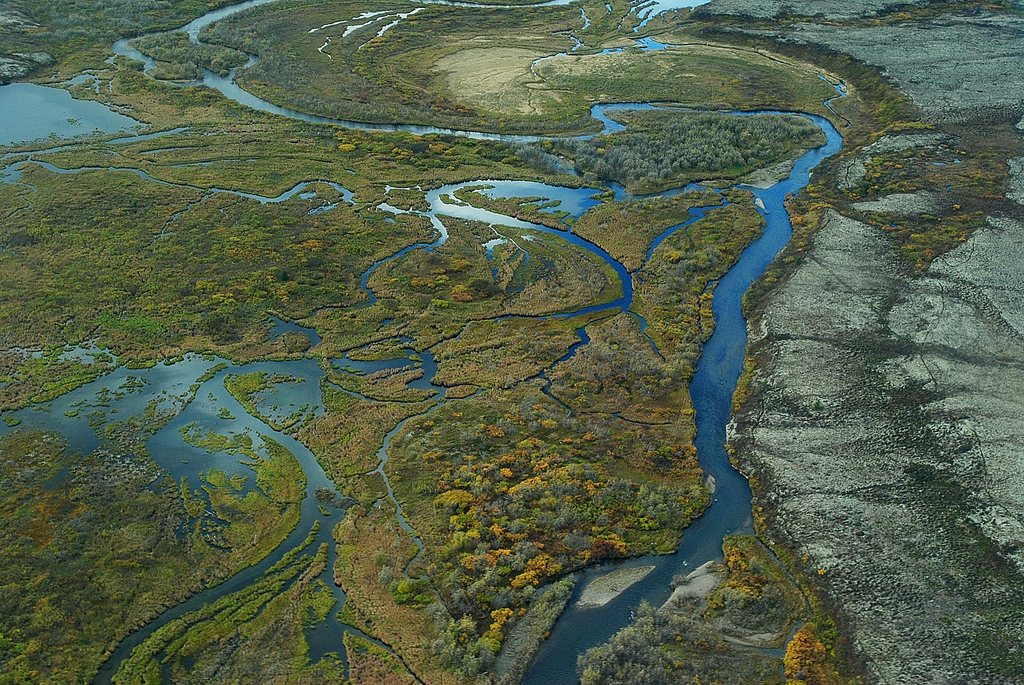
When a wetland is converted to something other than a wetland, federal law requires that the developer make up for the loss in some other way.
For big projects, that often means creating or protecting wetlands in other places. But, over the last three years, this hasn’t been happening as often as it used to, and conservation groups are concerned.
Whether the mitigation change is intentional or incidental is disputed.
Brad Meiklejohn has been involved in wetland mitigation projects in Alaska for 20 years, as director of the Conservation Fund. He’s concerned that there’s been a change in direction.
“Alaskans have a lot to be proud of,” he said. “We’ve done a lot of things right. We haven’t screwed up our waterways and our wetlands. That’s why we have the quality of life that we are afforded here: lots of salmon, lots of moose, lots of birdlife.”
The U.S. Army Corps of Engineers decides what wetland development projects require mitigation plans — such as restoring or preserving wetlands on another part of the same property or wetlands being preserved or restored on another property — like the ones Mieklejohn works on.
The corps has required a lot less of this kind of mitigation and in the past three years than it did in the previous several years.
For example, for one large category of project permits – known as individual permits – the share of permits for which the Corps required mitigation was 55 percent from 2010 to 2013. That fell to 24 percent from 2014 to 2016.
Meiklejohn said he believes the corps has lowered its standards.
“We’re seeing a pattern where permittees are being encouraged to lowball their mitigation expectations and basically getting away with it,” he said.
Steve Brockmann in the U.S. Fish and Wildlife Service’s Juneau office said he’s also seen a change.
“In recent years, we’ve been less successful in getting what we consider adequate mitigation for substantial impacts, and we’re not quite sure why that is,” he said.
Corps officials deny there’s been a change.
Sheila Newman, who oversees wetlands regulation for the Corps in Alaska, said there have just been fewer projects in wetlands in recent years.
“I think it would be unfair to look at those numbers and say that there had been a change, because those numbers don’t reflect the type of projects,” she said.
The Southeast Alaska Land Trust helps preserve land to offset wetlands development. For several years, it worked on mitigation estimates for roughly 15 to 20 wetland projects a year.
But since May 2015, it’s been asked to only look at one.
Land Trust Director Allison Gillum said she doesn’t know – other than the slump in the economy and state spending — why the drop happened.
“To see the decrease that we’ve seen, I think, potentially, there’s something else kind of also driving the change that we’ve seen here,” she said. “I don’t think we 100 percent know what that is.”
One thing that appears to have changed is the direction the corps gives the project managers who make decisions about compensatory mitigation.
KTOO obtained a 2014 document labeled “For Internal Use Only” that gave examples of cases that would require offsets.
These examples were more limited than those in an earlier guide that was publicly available.
Meiklejohn said appropriate mitigation is crucial for future projects, like the proposed natural gas pipeline.
“We’re talking about a project that crosses basically the heart of Alaska – countless rivers, wetlands throughout, a lot of those rivers are anadromous fish rivers,” he said. “They’re rivers that Alaskans use, that Alaskans live on and rely on the water quality thereof and the fish and wildlife that those rivers provide.”
Corps officials said it’s too soon to talk about the potential effect of the pipeline on wetlands.
The corps recently ended the Conservation’s Fund participation in the mitigation program citing the Fund’s failure to meet federal deadlines.
And with the end of the Conservation Fund’s mitigation program, there are no active mitigation programs in northern or western Alaska, or in much of the interior.
Just who will be responsible for mitigation in those areas is not clear now.
One more unknown for the future of wetland preservation in Alaska is the Trump administration.
Conservations groups don’t know what changes might be in store for the state.
